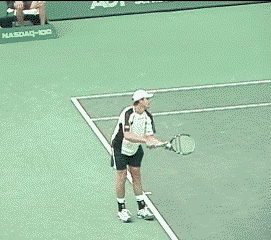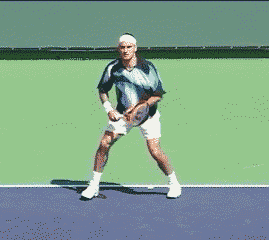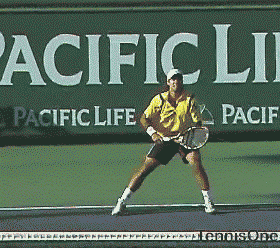|
TennisOne Lessons Keys to Coaching a Tennis Professional David Sammel and Jim Edgar The number of times I’ve heard the words “I want to be a pro tennis player” is long past the counting stage. “How do you hope to achieve this” I reply. The answer invariably is along the lines of “by practicing a lot and working hard”.
This is a wonderful ambition and like anything it has to be carefully planned with a simple clear path laid out. More importantly a clear understanding of what you are trying to do is imperative. There are three basic skills necessary to becoming a successful tennis player:
For example – would Carl Lewis have been a top class player had he chosen tennis rather than athletics? The answer is we do not know. It would depend on whether he has the necessary racquet ability. We know the physical and mental skills of a champion are present so the only question mark would be the racquet ability. It is my opinion that a marked deficiency in any of the three skill areas counts a player out. If you analyze the top players under these three categories it is easy to see which of the three areas is the foundation of their game. The beauty of tennis is the possibility of compensating to some extent for one of the skills through discipline and hard work. This leads me to what I believe is the most important coaching skill in producing a player.
Never forget that Tennis is an individual game so keep it individual to each pupil while getting the fundamental basics correct. I have always treated my pupils as individuals in terms of how their playing styles develop. I have never stuck rigidly to a single ’method’ or style of teaching as experience has taught me that each player must develop his or her unique technical and tactical method of play based on his or her abilities. I have tried to avoid the mistake of treating girls and boys in the same way and I have never taught my pupils the things that I did just because they worked for me when I used to play. This approach makes no sense in a sport that has changed so much in the last 10-15 years that those techniques and tactics are now largely obsolete. As I will explain, whatever game plan you develop, certain basics or fundamentals must be put in place if players are to have a chance to achieve their potential. Pupils come in all shapes and sizes, with widely differing physical and mental abilities and capacities. It is important not to assume that all will be capable of playing the same way, with the same technique and tactics. Physical and mental maturation takes place at different timescales in children and even when they have matured they are still very different and their method of play must reflect this. One only has to look at the top players in the world to see how they have honed their unique abilities into successful playing methods. The slightly built Lleyton Hewitt uses his natural speed and incredible competitive willpower to produce a playing method founded on unshakeable consistency. In contrast Andy Roddick is a physical giant with perhaps less natural speed and consistency than Hewitt but he uses his huge power on serve and forehand as his major weapons. Two different methods of play, but equally successful in players who are winners of Grand Slam tournaments.
It is easy when looking at the finished product to see how obvious it is that Hewitt and Roddick would end up playing the way they do. However consider whether this was so obvious when both boys were 12 years old without the benefit of hindsight. Perhaps not! It is more than likely that they were guided by experienced coaches to become the players they are. That is why we must be very diligent as coaches to ensure that our pupils get the right advice and direction in their long-term development as players. Taking a talented player through 8 years old to 15 or 16 is a difficult task , but helping them develop a playing method that takes advantage of their natural abilities is the key to giving them a chance of success. Developing an individualized playing method/game plan Your initial objective with a new pupil is to get to know their game so you can assess them in the four Performance factors (Technical, tactical, mental, physical). Build up a clear picture in the first 2-3 months of how they play matches. Tell the player how you think they could develop their game in the future. Explain how you see them maximizing their technical and tactical abilities and create a game plan with them (players love to know where they are going with their tennis. It motivates them to know exactly what type of player they are aiming to be). Having an agreed game plan also has the added benefit of committing the player to a certain method of play and this often removes nerves at key moments in matches. This game plan does not need to be rigidly fixed at this point because the age of the player will determine how flexible it can be. If the player is 10 years old the plan can evolve as the player grows physically and be less detailed than for a player aged 14 or older. Below are some notes to help guide you. They are not intended to be 100% accurate but will give you some insight into how personality can be linked with playing method. Types of Player There are three ways to play in the modern game. Either you are an aggressive baseliner/counter puncher, an attacker, or that rare breed with a very good all court game. There is no place in the game now for a purely consistent baseliner or defensive player. Also, the out and out Serve and Volley player and net rusher is almost extinct. A sophisticated approach to getting forward is now essential with serve and volley used as part of a strategy of attack not as a routine. It is important to have a solid all round game but you have got to know what your game plan is going to be. The coach must decide how his talented pupil is going to play – have an end picture in mind and work back from that. Aggressive Baseliner/counter puncher
If a young player has an excellent semi-western forehand and is very steady from the baseline (commonly known in junior tournaments as a hacker), contrary to popular belief, the coach has a wonderful base from which to work. The player must understand that he must use height and spin created by racquet head speed to get length because this will lead to him receiving shorter balls. The coach has then to develop pace and penetration from the mid court area. The child must learn to love the short ball and to be devastating from this area. Drive volleys and finishing volleys are the final touch for this style of player. The counter puncher must learn to have patience to hit with length and wait for the chance to attack the short ball, or to bring a player into the net on his terms to set them up for the lob or the pass. He must then learn that other players will combat his style of play by approaching the net which leads to teaching a topspin lob and being able to bring the ball down for a pass. As his game becomes more sophisticated, patterns of play must be drilled and grooved which is the basis of good percentage tennis. Mental: Aggressive and proactive. Works the point to hit winners or force the error from the opponent. Not scared of making errors in forcing play. More of a gambler than the historical “consistent baseliner”. Physical: Must be very strong with dynamic movement and ultimately very quick. Technical: Usually has a good serve and solid return and at least one ground stroke will be a major weapon. Forehand grip will be semi western. Has the ability to produce great racquet head speed and probably will develop an excellent drive volley.
The Attacker Needs to be solid and penetrating enough form the back court to receive a shorter ball where again the player must be extremely damaging from the mid-court area with good approach shots. Obviously hours must be spent on net play, the place where the attacker wants to be at the end of most points. A good serve is essential and the ability to serve and volley fairly regularly is also vital for this player. It is also crucial that the player can attack second serves by taking the return early so most points begin with this type of player dictating the play. This player must be taught to have the discipline and courage to go forward on big points. Mental: Very aggressive and/or impatient. Likes to force the issue and finish points rather than wait for the error. Enjoys taking risks and will often commit to going forward even if an opponent passes them often. Not particularly outcome orientated. Would rather perform game plan effectively than win by another method. Looks to attack the net and force opponent to make passing shots. Dislikes long groundstroke drills and can be sloppy in training. Physical: Usually tall with athleticism approaching that of basketball players. Technical: Very powerful serve and excellent volley and smash. Grips are usually conventional Eastern. All court playerThe All Court Player needs to be very proficient in all areas of the game. It is still vital that this player is aggressive. The skill in teaching this fabulous talent is the right choice of shot at the correct time. This boils down to understanding percentage tennis because players with great skill often try the low percentage shot because they know that it is possible. This leads to over playing and then indecision.
Generally it takes longer to learn what is appropriate for this player which possibly explains Federer winning his first Slam at 22 because his mental choices needed sharpening. It is being able to define the style for the moment. Mental: Open minded and receptive to new ideas. Not scared to try out new things or to make mistakes. Not easily embarrassed. Perhaps more artistic than the player types above. Can adapt tactics during matches and often a very good decision maker under pressure. Relaxed about life and sees the game as an opportunity to express this. Perhaps not the most consistent player in training. Physical: Quick and with very explosive movement. Flexible and strong in all areas of the body. Technical: Very solid in all strokes. No major technical weaknesses. Grips are often Eastern. Good range of strokes. Slices and hits topspin well. Particularly strong at serve, volley and smash. Weight of shot may be less than for the aggressive baseliner. You now have to ask yourself whether the player is physically, mentally and technically capable of playing they way they want to. Is their chosen game plan the one that best utilizes these unique abilities? This is where you really earn your stripes as a performance level tennis coach. Helping the player develop the game plan that uses their skills to their maximum is a considerable skill. However, before you can go further you still need to ensure the player’s development is not limited by poor technical mechanics. Basic Fundamentals You must ensure your pupil has the basic fundamentals to carry out their chosen game plan. Whatever the game plan you and your pupil are committed to, there are certain key technical areas that must be correct for future development. These should be set as early as possible (preferably by the age of 10 yrs). Below I have outlined what I believe they are:
Ball placement and contact height must be correct. Explosive transfer of body weight up to and through the ball must be achieved and fast racquet head speed developed. A totally reliable second serve with spin and placement must also be a priority. You cannot sidestep these basics or you will be unable to maximize the long-term potential of the player. Below are some more helpful tips. 1) Don’t use the exception to disprove the rule We all know a coach who is teaching a young player (8-11 years old) with an unconventional technique. The coach may point out that a particular world-class player has a similar technique and uses it successfully so why not let the pupil stick with it? Further, the coach may try and convince you (and himself) that the shot stands up during lessons and looks fine. His pupil will be the exception to the ‘rule’ and win with this non-textbook technique. However, it is possible that the technique will have limited development as the player gets older and that he or she does not have the natural ability to improvise in the same way as the world-class player does. Or possibly, the coach does not realize that the unconventional technique breaks down in matches, as he may not regularly see the pupil in tournaments. Around the time I started coaching, Boris Becker won Wimbledon with his distinct Eastern forehand service grip. Many of my pupils who were struggling to change to a more conventional grip on serve asked me why they couldn’t stick to their forehand grips like Boris. After all, Boris was the youngest Wimbledon Champion and his serve was much better than my own (with a continental grip)! I explained that Boris had a wrist and forearm twice as strong as a normal person and that his service grip was a one-off! I stuck to my guns and patiently continued developing their service grips.! Try to see beyond the immediate success of unconventional technique. Look to the future. Will the technique really hold together as it has to face harder shots as the player gets older? Perhaps it would be better to ‘bite the bullet’ and alter the shot now before it becomes even more ingrained. 2. Teaching young top players to copy the Pro’s isn’t always a good idea. Players aged 11 or younger are often taught to copy the technique of top pro’s. I believe that in some cases this is a bad idea.
We know that top players have increased the hip and upper body rotation on their groundstrokes in the last 10 years. Rotation, especially in the upper body on the forehand follow through is a product of the huge racquet head speed that players now generate. As the racquet accelerates more, the length of its deceleration will increase thus creating greater rotation. However, actively teaching under 11 players to rotate as much as this without being able to generate the racquet head speed is at best pointless. At worst it can lead to poor timing at contact and loss of balance as the player pulls their upper body too far to the backhand side. I believe that we must understand clearly how technique develops progressively in tune with physical development. To teach a 11 year old player to copy all the techniques of an adult professional tennis pro is not sensible. 3) Don’t teach out of a player something that is natural to them if it works No coach wants to hear this, but often the most consistent skill that your pupil possesses is probably the one that you did not teach him/her! When you have a pupil with a superb, natural stroke, just go with it and encourage the player to enjoy hitting it without too much thought. Huge damage is often done when an over zealous coach tampers with a natural shot that works fine. I have a pupil who is 14 years old with a very good serve. I make sure he practices aiming at targets for at least 15-20 minutes of every individual lesson we have. He asked me recently why I had never really taught him anything about his serve, just encouraged him to generate an explosive movement and get racquet head speed. I told him there was nothing technical that it needed and I just reminded him that as he grows it would get more powerful and become his biggest weapon. I do not feel bad about having no technical job to do here, even though I love teaching the serve. Do not fix a natural technique unless it doesn’t work. ConclusionA good game plan only works if the tools are present in the player. If a person was dropped 10 miles from the North Pole in normal clothes and told to walk to the North Pole it would not matter how mentally tough that person was, they would not reach the North Pole. The correct training, clothing and equipment would be needed to survive and even then it is a difficult challenge. A mentally tough player will not come through without the necessary technical and physical skills, just as a walker to the North Pole would have to prepare extremely well for a chance to survive the journey. The coach has to give the player the necessary information and direction. The player brings the desire, discipline and the natural skills to the table. The coach needs to give the player a clear picture of what type of game they will play not only for the players benefit but for his own. It keeps a constant direction in the coaches teaching. It is also important not to impose your personal preferences for playing on the player but rather to carefully assess the style most suitable to exploit the player’s strengths and personality. It is also desirable to give the player a role model to follow (i.e. a top 10 player in the world). Begin with the end in mind! (Stephen Covey ‘First things first’) |



